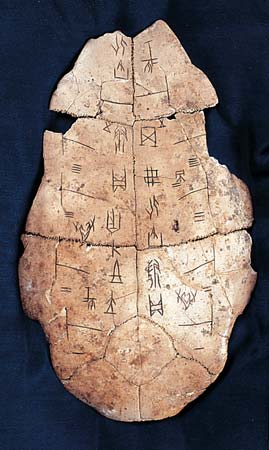We have all had our fair share of curiosity when it comes to predicting our future. We buy magic 8 balls, and go to fortune tellers. This same curiosity was present all the way back to 1600 BCE, in the Shang Dynasty of China, but at that time magic 8 balls had not been invented. Instead, the Shang created Oracle Bones to see what their futures held.
Oracle bones are pieces of ox scapula or turtle plastron, which were used for pyromancy, a method of telling the future using fire, in ancient China, mainly during the Shang dynasty. The oracle bones of this dynasty are said to have been unearthed over a period of many years by local farmers in three different Chinese dynasties, but local inhabitants did not realize what the bones were, and most times they simply reburied them. During the 1800’s, Chinese villagers were digging in the fields when they discovered a number of these bones and used them as “dragon bones,” which was a traditional Chinese medicine practice of grinding up fossils from almost twelve thousand years ago into tonics or poultices. The turtle shell fragments were prescribed for malaria, while the other animal bones were mixed and produced into a powder to treat knife wounds.1

The Diviners would ask Chinese deities questions directed towards their own ancestors, considering that their faith placed a strong respect towards for elders. Other questions asked addressed future weather, crop planting, the futures of members of the royal family, military matters, hypothetical business endeavors, and more. These questions were carved onto the bone or shell in a special form of Chinese characters known as oracle bone script, using a sharp tool. During the special session, the bone was often covered in blood along with the name of the diviner and the date for record keeping purposes. Heat was then applied with a metal rod until the bone or shell cracked due to the bone expanding because of the heat. The diviner would then interpret and analyze the pattern of cracks and write the predicted future on the piece as well, and in some cases recorded the outcome on the bone, provided the bone was still intact by the end of the divining session. By the time of the Zhou dynasty, cinnabar ink and brush had become the preferred writing method, resulting in fewer carved inscriptions and often blank oracle bones being unearthed.2

The oracle bones also bear the earliest known ancient Chinese writing and contain important significant information such as the complete royal genealogy of the Shang dynasty, or a complete royal family tree. When they were discovered and deciphered in the early twentieth century, these records confirmed the existence of the Shang, which some scholars had doubted until then. Scholars then discovered a variety of 4500 characters written on the oracle bones, but only discovered what 1700 of these characters meant. The resemblance between the oracle bone script and the modern Chinese script is an obvious one, and scholars were able to identify the meaning behind the script because of this.3
To this day oracle bones are still being discovered in many areas of the Zhōuyuán, which is the original location of the Zhou. Although many oracle bones have been found, few were inscribed. It is thought that a new writing method had been discovered and pyromancy was no longer used.
- John King Fairbank and Merle Goldman, China: A New History (Cambridge, Mass: Belknap Press of Harvard University Press, 1998), 152. ↵
- Peter Hessler, Oracle Bones : A Journey between China’s Past and Present (New York : HarperCollins, 2006), 33. ↵
- Fei Deng and Xu Wen, “On the Image Schemas of Time Expressions in the Oracle-Bone Inscriptions of Ancient China’s Shang Dynasty,” Journal of Sino-Western Communications vol 4, no. 2 (Dec 2012): 91. ↵



30 comments
Clarissa Bustamante
This is such an intriguing article! I’ve always been unaware of what the oracle bones were and now after reading about this topic it is fascinating how the oracle bones are used for medical purposes. Also, it is neat that the bones gave us an insight as to what the Chinese traditions were like. It’s also amazing how these oracle bones are still being searched for to this day.
Chris
You know china is offering $15 k for each deciphered character of the mystery text on the ancient oracle bones
Johnanthony Hernandez
Great article, interesting to think that the Ancient Chinese thought that using bones and fire would help them see the future of an individual. While at the same time using the same bones to keep the records. Not many civilization used this practice, to my knowledge, while at the same time believing that the answers given to them by the Oracle were the answers to their future. Interesting how the writing that was found on the bones eventually became he precursor to the modern Chinese language.
Nicolas McKay
You did a wonderful job on your article Kimberly! It was very interesting to rad how much faith people put into the bones they dug from the ground, actually beleiving hat they once belonged to dragons. They certainly put more stock into them than many of us put into our magic 8 ball. Its crazy to think that an object, much less a bone, that existed so long ago could still exist today, and they continue to find them. perhaps there is a little magic behind them after all.
Samuel Sanchez
Good job with your article. I did not know about the oracle bones. Interesting how they were used for medicine and to predict the future. It was good thing that the oracle bones were discovered it gave us an insight on Chinese traditions. We able to discover Chinese ancient writing and we able to obtain information such as the genealogy of the Shang dynasty. These bones are very significant even today we can learn so much from them. Good topic.
Aimee Trevino
Really interesting! I never knew much about the Chinese, and especially not about their caligraphy. I find it very interesting that they used these bones for medicine and to tell the future. I also think it is interesting that they thought about their futures, and tried predicting it. I really enjoyed your writing style, as it all flowed into a brief story while really explaining.
Briana Bustamante
Such a well written article! At first I was unaware of what the Oracle Bones were. I found it fascinating that they were used for medical purposes. They literally used the bones for everything! Thankfully these Oracle Bones were discovered, and they were able to give us an insight to the Chinese traditions. Also, I find it is fascinating that oracle bones are still being discovered in many areas Zhōuyuán. Very interesting topic!
Natalia Zuniga
It is unfortunately not much to read or learn about the Asian cultures, especially the Chinese. They had a quite advanced civilization well before the more famous ones in Europe. It was interesting to hear how much of an effect this had on their culture and everyday lives and how it influenced today with writing. Chinese being such a complicated language it was great to see early on it played into their lives.
Tina Valdez
I did not know that the discovery of these oracle bones is ongoing. I was also not aware of the insight they brought regarding writing methods. The use of oracle bones is interesting, but their discovery has been even more interesting; to have a better record of the earliest known ancient Chinese writing because of these bones is very significant. Great article, very interesting topic!
Nathan Cantu
I really enjoyed this article because fortune telling and tarot card reading is very fascinating to me. I like how different cultures come up with different ways of predicting the future and what materials they use or make to depict the future of our world. This article is very informative of how the Shang dynasty used the bones in many different ways. Great Job.